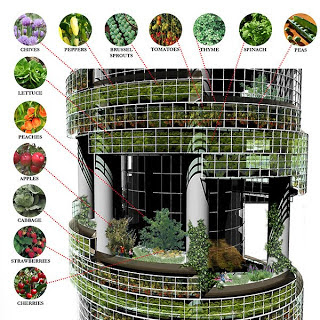

| Visitors Now: | |
| Total Visits: | |
| Total Stories: |

| Story Views | |
| Now: | |
| Last Hour: | |
| Last 24 Hours: | |
| Total: | |
The Low-Cost Innovation of Vertical Farming
Natural Blaze.com
Traditional agriculture has been suffering worldwide. Extended severe weather events have cut many crop harvests in half. Farmers are going bankrupt as crops fail, commodity prices are exploding, and millions of people more have been added to the list of those who go hungry on a regular basis.
However, in times of hardship come great innovation. There is an Organic Revolution taking place that is focused on self-sufficiency as the primary goal, free of genetic modification of the food supply brought to us by companies like Monsanto.
People everywhere are beginning a pursuit of living a simpler, healthier, and less-dependent lifestyle.
Our modern way of life is centered on mega-cities. This is likely to continue, as the percentage of the global population living in, or very close to, major cities rises past 80%. It would make sense, then, that any new innovative farming system should begin here, as it will benefit the greatest number of people, while offering low-cost solutions for abundance within a small space.
Mega-corporations continue to sell us their so-called farming innovations, despite their obvious flaws and dangers. One farming method in particular shows great promise for growing local non-GMO food on a small footprint of land, and may be instrumental in feeding a growing world population living in city environments: vertical farming.
The traditional skyscraper is a massive amount of vertical space with potential to incorporate nature into this symbol of the urban landscape. According to Vertical Farming’s founder, Dickson Despommier, a thirty-story building could feed 50,000 people. An estimated 165 of these “farmscrapers” would feed all of New York City — each building with the footprint of 1 city block (approximately 1 acre). His calculations were based on a project he assigned to his students at Columbia University.
Indoor farming is, of course, nothing new, but as Despommier mentions on the Vertical Farm Web Site, “What is new is the urgent need to scale up this technology to accommodate another 3 billion people.”
The concept of Vertical Farming solves a multitude of problems; Verticalfarm.com lists 15 advantages. Here are some highlights:
- Year-round crop production: 1 indoor acre is equivalent to 4-6 outdoor acres or more (strawberries for example would be a 1 acre indoor to 30 acre outdoor equivalent
- No weather-related crop loss.
- All VF food is grown organically: no herbicides, pesticides, or fertilizers.
- VF virtually eliminates agricultural runoff by recycling black water.
- VF dramatically reduces fossil fuel use (no tractors, plows, shipping).
- VF converts abandoned urban properties into food production centers.
- VF could reduce physical conflicts resulting from battles to control limited resources.
- And Vertical Farming is not limited to produce; preliminary plans include chickens, ducks, geese, fish, crustaceans, and mollusks to be raised within the same building, creating one large integrated system of food production.
Vertical Farming could very well be the answer for supplying the world’s growing population who are destined to go hungry if real innovative solutions are not implemented quickly. Instead of blaming humans for their innate desire to extend their species and enjoy their families, no matter how large, solutions like vertical farming are at once empowering to individuals and considerate of the collective needs of greater humanity.
The economic crisis has left abandoned buildings and empty malls and houses in its wake. Think of Detroit, for example: what a great concept Vertical Farming would be in a place that has upwards of 50% unemployment, and a completely ravaged urban environment. Buildings can now be bought for pennies on the dollar, and the vast unemployment offers a ready and willing labor pool. Vertical Farming is urban revival at its most basic level. It is also a reminder that anyone can grow a self-sustaining amount of food even if a large plot of farmland is not available, or is beyond one’s budget.
Here is one example of vertical farming going mega in Chicago:
Are you or anyone in your community engaged in Vertical Farming or other methods of urban agriculture? Please tell us your story in the comments section below or contact us at … and be featured here at Natural Blaze in our next article.
\”Blazing a path to natural health and wellness. Get natural health
news, remedies and tips at naturalblaze.com\”
2013-04-13 14:45:07
Source: http://www.naturalblaze.com/2013/04/the-low-cost-innovation-of-vertical.html
Source:






There are crop failures, sure. But most of the recent once have been Monsanto crops. We don’t need fancy vertical grown crops, because it’s hydroponic and it cost too much to run. Also because the water is recirculated, one infection and you lose the lot. Compared with traditionally grown crops, one infection you lose one plant. The reason you don’t see farmers using hydroponics is the huge expense.
Perfectly ok for grow your own though… if you are into chemical food. Because you need to add chemicals to stop infections, and chemicals to fertilise the plants and more chemicals to balance the water ph. Bon apetit.